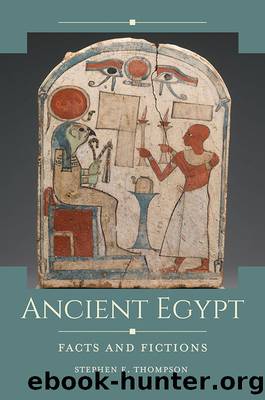Ancient Egypt by Stephen E. Thompson

Author:Stephen E. Thompson
Language: eng
Format: epub
Publisher: ABC-CLIO
Published: 2020-02-14T16:00:00+00:00
What Really Happened
Slavery in ancient Egypt is a much-debated topic, for several reasons. The meaning of the term slave, and the definition of slavery, are very much culturally dependent. A student in the United States familiar with the history of slavery there has a concept of slavery involving a racial component, an aspect of slavery absent in ancient Egypt. Scholars have yet to come to an agreement on a definition of slavery that would be valid for all cultures across history. Orlando Patterson has defined slavery as âthe permanent, violent, and personal domination of natally alienated and generally dishonored persons.â According to Patterson, a slave is always âan excommunicated person,â lacking an independent social existence (quoted in Davis 2006, 30â31). As we will see, several aspects of this definition of slavery do not apply to ancient Egypt. A more limited definition of a slave is a person who may be bought or sold (Cruz-Uribe 1982, 47). There is no doubt that during certain periods of Egyptian history, it was possible for a person with means to buy other people. For example, the First Intermediate Period official Merer states that âI purchased cattle, I purchased people, I purchased fields, (and) I purchased copper.â
Several words in the Egyptian vocabulary refer to individuals who, at various times in their lives, were subject to involuntary servitude, whether or not any should be translated as âslaveâ has been a matter of much discussion. The most common terms translated as âslaveâ are hem, bak, and meret. Meret is a collective term, not used to refer to an individual. It is uncertain the extent to which these terms would refer to a slave, meaning a person subject to being bought and sold, rather than some other form of compulsory labor, such as conscript labor (sometimes referred to as corvée labor) or serfdom, in which an individual is tied to a particular piece of land and when the land changes ownership, the person does as well but is not subject to sale apart from the land.
We must also keep in mind that the Egyptians had no conception of what we would term human rights; all Egyptians were in some sense subservient to someone above them, and the king was subservient to the gods. An absolute separation between the status of free and slave would not have existed in ancient Egypt. Rather, people existed on a sliding scale, some freer than others, but all would have had obligations to the state. Finally, it is important to note that Egyptian history spans over three thousand years, and customs and practices changed and developed over that time.
As noted previously, one of the factors contributing to the notion that ancient Egyptian society was built on the backs of slaves is the mere existence of the great pyramids at Giza. Recent archaeological discoveries, however, have revealed that much of the labor used in constructing the pyramids was skilled labor, and the workers were well compensated for their work. Within the last few decades,
Download
This site does not store any files on its server. We only index and link to content provided by other sites. Please contact the content providers to delete copyright contents if any and email us, we'll remove relevant links or contents immediately.
| Africa | Americas |
| Arctic & Antarctica | Asia |
| Australia & Oceania | Europe |
| Middle East | Russia |
| United States | World |
| Ancient Civilizations | Military |
| Historical Study & Educational Resources |
The Battle of Mogadishu by Matt Eversmann & Dan Schilling(723)
The Confidence Men by Margalit Fox(671)
A History of the Muslim World since 1260: The Making of a Global Community by Vernon O. Egger(641)
The Spymaster of Baghdad by Margaret Coker(641)
Jack the Ripper and the East End by Peter Ackroyd(609)
Empire of Fear: Inside the Islamic State by Andrew Hosken(586)
The Afghanistan File by Prince Turki AlFaisal Al Saud(586)
The Crimean War by Winfried Baumgart(578)
Islam At The Gates: How Christendom Defeated the Ottoman Turks by Diane Moczar(572)
The Jerusalem Diamond by Noah Gordon(567)
Akhenaten by Dominic Montserrat(565)
A Concise History of Greece (Cambridge Concise Histories) by Richard Clogg(554)
Beirut 2020 by Charif Majdalani(554)
The History of Jihad by Robert Spencer(548)
Israel: Ancient Kingdom or Late Invention? by Daniel I. Block(532)
Enemy in the East by Rolf-Dieter Müller(532)
The Privatization of Israeli Security by Shir Hever(526)
The Nine Lives of Pakistan by Declan WALSH(521)
Destroying a Nation: The Civil War in Syria by Nikolaos van Dam(516)
